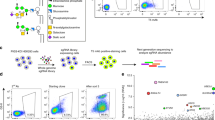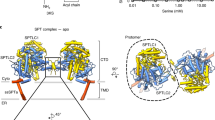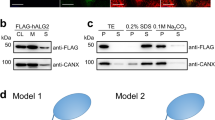Abstract
The molecular machinery responsible for the generation of transport carriers moving from the Golgi complex to the plasma membrane relies on a tight interplay between proteins and lipids. Among the lipid-binding proteins of this machinery, we previously identified the four-phosphate adaptor protein FAPP2, the pleckstrin homology domain of which binds phosphatidylinositol 4-phosphate and the small GTPase ARF1. FAPP2 also possesses a glycolipid-transfer-protein homology domain. Here we show that human FAPP2 is a glucosylceramide-transfer protein that has a pivotal role in the synthesis of complex glycosphingolipids, key structural and signalling components of the plasma membrane. The requirement for FAPP2 makes the whole glycosphingolipid synthetic pathway sensitive to regulation by phosphatidylinositol 4-phosphate and ARF1. Thus, by coupling the synthesis of glycosphingolipids with their export to the cell surface, FAPP2 emerges as crucial in determining the lipid identity and composition of the plasma membrane.
This is a preview of subscription content, access via your institution
Access options
Subscribe to this journal
Receive 51 print issues and online access
$199.00 per year
only $3.90 per issue
Buy this article
- Purchase on Springer Link
- Instant access to full article PDF
Prices may be subject to local taxes which are calculated during checkout




Similar content being viewed by others
Change history
06 September 2007
In the AOP version of this Article, the y-axes of Fig. 2c was incorrectly labelled. This was corrected on 6 September 2007.
References
Bard, F. & Malhotra, V. The formation of TGN-to-plasma-membrane transport carriers. Annu. Rev. Cell Dev. Biol. 22, 439–455 (2006)
Luini, A., Ragnini-Wilson, A., Polishchuk, R. S. & De Matteis, M. A. Large pleiomorphic traffic intermediates in the secretory pathway. Curr. Opin. Cell Biol. 17, 353–361 (2005)
De Matteis, M. A. & Godi, A. Protein–lipid interactions in membrane trafficking at the Golgi complex. Biochim. Biophys. Acta 1666, 264–274 (2004)
Godi, A. et al. FAPPs control Golgi-to-cell-surface membrane traffic by binding to ARF and PtdIns(4)P. Nature Cell Biol. 6, 393–404 (2004)
Vieira, O. V., Verkade, P., Manninen, A. & Simons, K. FAPP2 is involved in the transport of apical cargo in polarized MDCK cells. J. Cell Biol. 170, 521–526 (2005)
Vieira, O. V. et al. FAPP2, cilium formation, and compartmentalization of the apical membrane in polarized Madin–Darby canine kidney (MDCK) cells. Proc. Natl Acad. Sci. USA 103, 18556–18561 (2006)
Levine, T. P. & Munro, S. Targeting of Golgi-specific pleckstrin homology domains involves both PtdIns 4-kinase-dependent and -independent components. Curr. Biol. 12, 695–704 (2002)
Brown, R. E. & Mattjus, P. Glycolipid transfer proteins. Biochim. Biophys. Acta 1771, 746–760 (2007)
Holthuis, J. C., Pomorski, T., Raggers, R. J., Sprong, H. & Van Meer, G. The organizing potential of sphingolipids in intracellular membrane transport. Physiol. Rev. 81, 1689–1723 (2001)
Nylund, M. et al. Molecular features of phospholipids that affect glycolipid transfer protein-mediated galactosylceramide transfer between vesicles. Biochim. Biophys. Acta 1758, 807–812 (2006)
Wiedemann, C., Schafer, T. & Burger, M. M. Chromaffin granule-associated phosphatidylinositol 4-kinase activity is required for stimulated secretion. EMBO J. 15, 2094–2101 (1996)
Brade, L., Vielhaber, G., Heinz, E. & Brade, H. In vitro characterization of anti-glucosylceramide rabbit antisera. Glycobiology 10, 629–636 (2000)
Malinina, L., Malakhova, M. L., Teplov, A., Brown, R. E. & Patel, D. J. Structural basis for glycosphingolipid transfer specificity. Nature 430, 1048–1053 (2004)
Klausner, R. D., Donaldson, J. G. & Lippincott-Schwartz, J. Brefeldin A: insights into the control of membrane traffic and organelle structure. J. Cell Biol. 116, 1071–1080 (1992)
Boot, R. G. et al. Identification of the non-lysosomal glucosylceramidase as β-glucosidase 2. J. Biol. Chem. 282, 1305–1312 (2007)
Yildiz, Y. et al. Mutation of β-glucosidase 2 causes glycolipid storage disease and impaired male fertility. J. Clin. Invest. 116, 2985–2994 (2006)
Hanada, K. et al. Molecular machinery for non-vesicular trafficking of ceramide. Nature 426, 803–809 (2003)
Mallard, F. et al. Direct pathway from early/recycling endosomes to the Golgi apparatus revealed through the study of Shiga toxin B-fragment transport. J. Cell Biol. 143, 973–990 (1998)
Young, W. W., Lutz, M. S., Mills, S. E. & Lechler-Osborn, S. Use of brefeldin A to define sites of glycosphingolipid synthesis: GA2/GM2/GD2 synthase is trans to the brefeldin A block. Proc. Natl Acad. Sci. USA 87, 6838–6842 (1990)
Mironov, A. A. et al. Dicumarol, an inhibitor of ADP-ribosylation of CtBP3/BARS, fragments golgi non-compact tubular zones and inhibits intra-golgi transport. Eur. J. Cell Biol. 83, 263–279 (2004)
Brown, W. J., Chambers, K. & Doody, A. Phospholipase A2 (PLA2) enzymes in membrane trafficking: mediators of membrane shape and function. Traffic 4, 214–221 (2003)
Drecktrah, D. & Brown, W. J. Phospholipase A2 antagonists inhibit nocodazole-induced Golgi ministack formation: evidence of an ER intermediate and constitutive cycling. Mol. Biol. Cell 10, 4021–4032 (1999)
Trucco, A. et al. Secretory traffic triggers the formation of tubular continuities across Golgi sub-compartments. Nature Cell Biol. 6, 1071–1081 (2004)
Yu, S. et al. mBet3p is required for homotypic COPII vesicle tethering in mammalian cells. J. Cell Biol. 174, 359–368 (2006)
Marra, P. et al. The biogenesis of the Golgi ribbon: the roles of membrane input from the ER and of GM130. Mol. Biol. Cell 18, 1595–1608 (2007)
Toth, B. et al. Phosphatidylinositol 4-kinase IIIβ regulates the transport of ceramide between the endoplasmic reticulum and Golgi. J. Biol. Chem. 281, 36369–36377 (2006)
Rosenwald, A. G., Machamer, C. E. & Pagano, R. E. Effects of a sphingolipid synthesis inhibitor on membrane transport through the secretory pathway. Biochemistry 31, 3581–3590 (1992)
Sprong, H. et al. Glycosphingolipids are required for sorting melanosomal proteins in the Golgi complex. J. Cell Biol. 155, 369–380 (2001)
Schwarz, A. & Futerman, A. H. Distinct roles for ceramide and glucosylceramide at different stages of neuronal growth. J. Neurosci. 17, 2929–2938 (1997)
Boldin, S. A. & Futerman, A. H. Up-regulation of glucosylceramide synthesis upon stimulation of axonal growth by basic fibroblast growth factor. Evidence for post-translational modification of glucosylceramide synthase. J. Biol. Chem. 275, 9905–9909 (2000)
Chang, M. C., Wisco, D., Ewers, H., Norden, C. & Winckler, B. Inhibition of sphingolipid synthesis affects kinetics but not fidelity of L1/NgCAM transport along direct but not transcytotic axonal pathways. Mol. Cell. Neurosci. 31, 525–538 (2006)
Tamboli, I. Y. et al. Inhibition of glycosphingolipid biosynthesis reduces secretion of the β-amyloid precursor protein and amyloid β-peptide. J. Biol. Chem. 280, 28110–28117 (2005)
Lannert, H., Gorgas, K., Meissner, I., Wieland, F. T. & Jeckel, D. Functional organization of the Golgi apparatus in glycosphingolipid biosynthesis. Lactosylceramide and subsequent glycosphingolipids are formed in the lumen of the late Golgi. J. Biol. Chem. 273, 2939–2946 (1998)
Raya, A. et al. Goodpasture antigen-binding protein, the kinase that phosphorylates the Goodpasture antigen, is an alternatively spliced variant implicated in autoimmune pathogenesis. J. Biol. Chem. 275, 40392–40399 (2000)
De Matteis, M. A., Di Campli, A. & D’Angelo, G. Lipid-transfer proteins in membrane trafficking at the Golgi complex. Biochim. Biophys. Acta 1771, 761–768 (2007)
De Matteis, M. A. & Godi, A. PI-loting membrane traffic. Nature Cell Biol. 6, 487–492 (2004)
Malakhova, M. L. et al. Point mutational analysis of the liganding site in human glycolipid transfer protein. Functionality of the complex. J. Biol. Chem. 280, 26312–26320 (2005)
Sala, G., Dupre, T., Seta, N., Codogno, P. & Ghidoni, R. Increased biosynthesis of glycosphingolipids in congenital disorder of glycosylation Ia (CDG-Ia) fibroblasts. Pediatr. Res. 52, 645–651 (2002)
Wing, D. R. et al. High-performance liquid chromatography analysis of ganglioside carbohydrates at the picomole level after ceramide glycanase digestion and fluorescent labeling with 2-aminobenzamide. Anal. Biochem. 298, 207–217 (2001)
Bielawski, J., Szulc, Z. M., Hannun, Y. A. & Bielawska, A. Simultaneous quantitative analysis of bioactive sphingolipids by high-performance liquid chromatography–tandem mass spectrometry. Methods 39, 82–91 (2006)
Godi, A. et al. ADP ribosylation factor regulates spectrin binding to the Golgi complex. Proc. Natl Acad. Sci. USA 95, 8607–8612 (1998)
Marra, P. et al. The GM130 and GRASP65 Golgi proteins cycle through and define a subdomain of the intermediate compartment. Nature Cell Biol. 3, 1101–1113 (2001)
Lodish, H. F. & Kong, N. Glucose removal from N-linked oligosaccharides is required for efficient maturation of certain secretory glycoproteins from the rough endoplasmic reticulum to the Golgi complex. J. Cell Biol. 98, 1720–1729 (1984)
Watt, S. A., Kular, G., Fleming, I. N., Downes, C. P. & Lucocq, J. M. Subcellular localization of phosphatidylinositol 4,5-bisphosphate using the pleckstrin homology domain of phospholipase Cδ1. Biochem. J. 363, 657–666 (2002)
Polishchuk, E. V., Di Pentima, A., Luini, A. & Polishchuk, R. S. Mechanism of constitutive export from the golgi: bulk flow via the formation, protrusion, and en bloc cleavage of large trans-golgi network tubular domains. Mol. Biol. Cell 14, 4470–4485 (2003)
Millar, C. A. et al. Adipsin and the glucose transporter GLUT4 traffic to the cell surface via independent pathways in adipocytes. Traffic 1, 141–151 (2000)
Acknowledgements
We thank A. Luini, R. Ghidoni, P. Viani, L. Riboni for discussions; A. Luini, D. Corda and M. Gimona for critical reading of the manuscript; T. Scanu for sharing the data on Bet3 knockdown; C. Iurisci for technical assistance; A. Spaar for the bioinformatic analysis; G. Perinetti for the statistic analysis of the data; J. P. Slotte for the fluorescence facility; J. Saus for anti-CERT antibody; C. P. Berrie for editorial assistance; and E. Fontana for the artwork. This work was supported by the Telethon Electron Microscopy Core Facility, by a fellowship from FIRC to G.D.A., and by Telethon, AIRC, the Academy of Finland, Sigrid Jusélius, Magnus Ehrnrooth, K. Albin Johansson Foundations, Medicinska Understödsföreningen Liv och Hälsa, ISB Graduate School and Åbo Akademi University.
Author Contributions M.A.D.M. supervised the entire project and wrote the manuscript with G.D.A. and with comments from all coauthors; G.D.A designed and conducted the experiments of sphingolipid labelling; G.D.A. designed the experiments of membrane trafficking, which were conducted by A.D.C. and G.D.T.; G.D.A. designed the cloning of FAPP2, which was conducted by G.D.T. and M.S.; G.D.T. and M.S. prepared all the constructs, recombinant proteins and anti-FAPP1, FAPP2, PI(4)KIIIβ, PI(4)KIIα, BET3 and GM130 antibodies; E.P. and R.P. designed and conducted the experiments for electron microscopy; A.G. performed the trafficking experiment in FAPP1-knockdown cells; P.M. designed the experiments of intervesicular lipid transfer, which were conducted by G.W.; A.S. and C.C.C. conducted the HPLC measurements of GSLs under the supervision of F.M.P.; J.B. conducted the sphingolipid analysis by LC–MS under the supervision of Y.A.H.
Author information
Authors and Affiliations
Corresponding author
Ethics declarations
Competing interests
Reprints and permissions information is available at www.nature.com/reprints. The authors declare no competing financial interests.
Supplementary information
Supplementary Information
This file contains Supplementary Data, Supplementary Figures S1-S7 with Legends, Supplementary Methods, Supplementary Discussion and Supplementary Notes with additional references. (PDF 1073 kb)
Supplementary Video 1
This file contains Supplementary Video 1 which shows an electron microscopy tomography of the Golgi complex in mock-treated HeLa cells. (MOV 1309 kb)
Supplementary Video 2
This file contains Supplementary Video 2 which shows an electron microscopy tomography of the Golgi complex in FAPP2-KD HeLa cells. (MOV 828 kb)
Supplementary Video 3
This file contains Supplementary Video 3 which shows an electron microscopy tomography of the Golgi complex in GCS-KD HeLa cells. (MOV 1181 kb)
Rights and permissions
About this article
Cite this article
D’Angelo, G., Polishchuk, E., Tullio, G. et al. Glycosphingolipid synthesis requires FAPP2 transfer of glucosylceramide. Nature 449, 62–67 (2007). https://doi.org/10.1038/nature06097
Received:
Accepted:
Published:
Issue Date:
DOI: https://doi.org/10.1038/nature06097
This article is cited by
-
It started with a western
Nature Cell Biology (2024)
-
The expanding organelle lipidomes: current knowledge and challenges
Cellular and Molecular Life Sciences (2023)
-
Phosphoinositides as membrane organizers
Nature Reviews Molecular Cell Biology (2022)
-
Glycosphingolipid metabolism and its role in ageing and Parkinson’s disease
Glycoconjugate Journal (2022)
-
Lipid Dyshomeostasis and Inherited Cerebellar Ataxia
Molecular Neurobiology (2022)
Comments
By submitting a comment you agree to abide by our Terms and Community Guidelines. If you find something abusive or that does not comply with our terms or guidelines please flag it as inappropriate.



